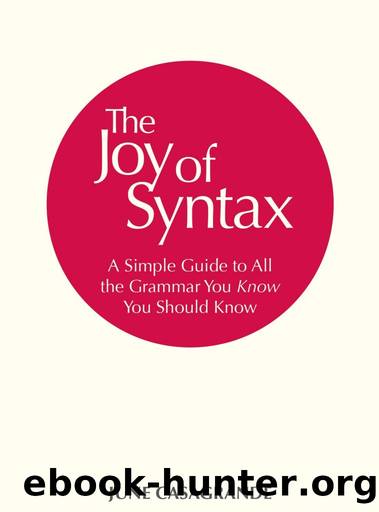The Joy of Syntax: A Simple Guide to All the Grammar You Know You Should Know by June Casagrande

Author:June Casagrande [Casagrande, June]
Language: eng
Format: azw3
Tags: Linguistics, Grammar, Nonfiction, Reference, Writing
ISBN: 9780399581076
Publisher: Ten Speed Press
Published: 2018-07-23T23:00:00+00:00
Verb Phrases
We can break verb phrases up into two groups: finite and nonfinite. Think of the finite ones as verbs conjugated to work with a subject.
Troy studies.
(Finite verb studies is inflected in number and person for the subject.)
Nonfinite verbs are not inflected to work with the subject and form a clause. Instead, they take other formsâoften participles, gerunds, and infinitivesâthat modify the main clause or serve other functions in the sentence. Here are two examples of nonfinite verb phrases at work:
Studying, Troy learned about ancient Rome.
(Participle studying is not inflected for the subject, and instead of forming the main clause, it modifies the main clause, or functions adverbially.)
To study, Troy needs complete silence.
(Infinitive to study is not inflected for the subject, and instead of forming a main clause, it functions adverbially.)
Like noun phrases, verb phrases can be just one word or more than one. The main verb is the head word. Other words in the phrase can be auxiliaries, modal auxiliaries, or modifiers like adverb phrases.
Kimberly changed careers.
Kimberly has changed careers.
Kimberly might change careers.
Thereâs a bit of disagreement about whether adverb phrases can be considered part of the verb phrase. But itâs often useful to see them as part of a single unit. In the following two examples, the adverbs come in the middle of the verb phrase. Allowing adverb phrases to be discussed as part of verb phrases lets us see these groupings more clearly.
Kimberly has recently changed careers.
Kimberly has only recently changed careers.
Another thing to know about verb phrases: they are where negation usually takes place.
As we saw in our verbs chapter, negation usually applies to the verb be, an auxiliary verb, or the dummy operator do.
I am not here.
(Negation applied to verb be.)
He has not confessed.
(Negation applied to auxiliary have.)
He did not confess.
(Negation applied to dummy operator do.)
Verb phrases agree in number and person with their subjects. In the simple present tense, all subjects but the third person singular use the base form of the verb. The third person singular uses the -s form: I go, you go, he goes, she goes, we go, they go. In the perfect tenses (present perfect and past perfect) and the progressive aspect, the auxiliary verbs agree with the subject but the participles are unchanging for every subject: I have gone, he has gone, she has gone, we have gone, they have gone; I am going, he is going, she is going, we are going, they are going.
Adjective Phrases
The two main jobs of adjective phrases are to premodify a noun and to serve as a subject predicative. Premodification just means that it comes before the noun it modifies.
Pretty lies will get you nowhere.
(Pretty modifies the noun lies.)
A subject predicative, as we saw in chapter 2, this page, is a reflection back on the subject that takes place in the predicate. It follows a copular verb like be, seem, appear, feel, and smell. Karen is nice. Gary seems upset. This coffee smells good.
Adjective phrases can be coordinate or noncoordinate. Coordinate adjective phrases
Download
This site does not store any files on its server. We only index and link to content provided by other sites. Please contact the content providers to delete copyright contents if any and email us, we'll remove relevant links or contents immediately.
Cecilia; Or, Memoirs of an Heiress — Volume 1 by Fanny Burney(31324)
Cecilia; Or, Memoirs of an Heiress — Volume 3 by Fanny Burney(30928)
Cecilia; Or, Memoirs of an Heiress — Volume 2 by Fanny Burney(30885)
The Lost Art of Listening by Michael P. Nichols(6462)
We Need to Talk by Celeste Headlee(4862)
Asking the Right Questions: A Guide to Critical Thinking by M. Neil Browne & Stuart M. Keeley(4566)
On Writing A Memoir of the Craft by Stephen King(4205)
Dialogue by Robert McKee(3575)
I Have Something to Say: Mastering the Art of Public Speaking in an Age of Disconnection by John Bowe(3512)
Pre-Suasion: A Revolutionary Way to Influence and Persuade by Robert Cialdini(3404)
Elements of Style 2017 by Richard De A'Morelli(2940)
The Book of Human Emotions by Tiffany Watt Smith(2767)
Good Humor, Bad Taste: A Sociology of the Joke by Kuipers Giselinde(2553)
Name Book, The: Over 10,000 Names--Their Meanings, Origins, and Spiritual Significance by Astoria Dorothy(2488)
Fluent Forever: How to Learn Any Language Fast and Never Forget It by Gabriel Wyner(2442)
The Grammaring Guide to English Grammar with Exercises by Péter Simon(2391)
Why I Write by George Orwell(2354)
The Art Of Deception by Kevin Mitnick(2294)
Don't Sleep, There Are Snakes by Daniel L. Everett(2212)
